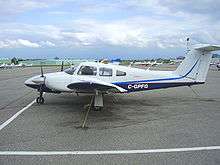Piper PA-44 Seminole
The Piper PA-44 Seminole is an American twin-engined light aircraft manufactured by Piper Aircraft.[3]
| PA-44 Seminole | |
|---|---|
 | |
| Role | Training and personal aircraft |
| Manufacturer | Piper Aircraft |
| First flight | 1976 |
| Produced | 1979–present |
| Number built | 926 (until 2019)[1] |
| Unit cost | |
| Developed from | Piper Cherokee |


The PA-44 is a development of the Piper Cherokee single-engined aircraft and is primarily used for multi-engined flight training.[3][4]
The Seminole was built in 1979–1982, in 1989–1990, and has been in production since 1995.
Design and development
The first production Seminoles are equipped with two 180 hp (135 kW) Lycoming O-360-E1A6D engines. The right-hand engine is a Lycoming LO-360-E1A6D variant, which turns in the opposite direction to the left-hand engine. This feature eliminates the critical engine and makes the aircraft more controllable in the event that an engine needs to be shut down or fails.[5][6]
The first prototype Seminole made its maiden flight in May 1976 and the type was publicly announced on February 21, 1978.[7] The Seminole was first certified on March 10, 1978 and introduced as a 1979 model year in late 1978. Gross weight is 3800 lbs (1723 kg).[6]
Later production Seminoles were built with Lycoming O-360-A1H6 engines.[6]
The PA-44-180T Turbo Seminole version was certified on November 29, 1979. It features two turbocharged 180 hp (135 kW) Lycoming TO-360-E1A6D engines, which offer a significant improvement in performance at high density altitude. The Turbo Seminole had its takeoff gross weight raised to 3925 lb (1780 kg), while the landing weight remained at 3800 lbs (1723 kg).[6]
The PA-44 features a high T-tail similar to the T-tailed Arrow IV. The Seminole is visually similar to the Beechcraft Duchess.[4]
Production of both versions of the Seminole was stopped in 1982, after 361 Seminoles and 87 Turbo Seminoles had been built. Production of the normally aspirated PA-44-180 restarted in 1988.[8] Changes were limited to modifications to the aircraft's electrical systems and instrumentation.[9] Production was stopped again in 1990 after 29 more aircraft had been delivered owing to Piper's financial problems.[10] Production restarted again in 1995.[11]
Variants
- PA-44-180 Seminole
- Normally aspirated version powered by two Lycoming O-360-E1A6D or two O-360-A1H6 engines.[6]
- PA-44-180T Turbo Seminole
- Turbocharged version powered by two Lycoming TO-360-E1A6D engines.[6]
- PA-44 Seminole DX
- A proposed diesel-powered variant powered by two Continental Motors CD-170 engines.[12]
Operators
Civil
The PA-44 is popular with air charter companies and flight schools, and is operated by private individuals and companies.
Specifications (PA-44-180 Seminole)
Data from Jane's All the World's Aircraft 1982–83[7]
General characteristics
- Crew: 1
- Capacity: 3 passengers
- Length: 27 ft 7 1⁄4 in (8.414 m)
- Wingspan: 38 ft 7 1⁄4 in (11.767 m)
- Height: 8 ft 6 in (2.59 m)
- Wing area: 183.8 sq ft (17.08 m2)
- Airfoil: NACA 652-415[11]
- Empty weight: 2,354 lb (1,068 kg)
- Max takeoff weight: 3,800 lb (1,724 kg)
- Fuel capacity: 110 US gal (92 imp gal; 420 L), of which 2 US gal (1.7 imp gal; 7.6 L) are unusable
- Powerplant: 2 × Lycoming O-360-E1A6 air-cooled flat four (counter rotating), 180 hp (130 kW) each
- Propellers: 2-bladed Hartzell fully-feathering metal constant-speed propellers, 6 ft 2 in (1.88 m) diameter
Performance
- Maximum speed: 193 mph (311 km/h, 168 kn)
- Cruise speed: 187 mph (301 km/h, 162 kn) (75% power)
- Stall speed: 68 mph (109 km/h, 59 kn) (flaps down) CAS
- Range: 1,053 mi (1,695 km, 915 nmi) (55% power)
- Service ceiling: 17,100 ft (5,200 m)
- Rate of climb: 1,340 ft/min (6.8 m/s)
- Single Engine Service Ceiling: 4,100 ft (1,200 m)
- Take-off to 50 ft (15 m): 1,400 ft (430 m)
- Landing from 50 ft (15 m): 1,190 ft (360 m)
See also
Related development
- Piper Cherokee
Aircraft of comparable role, configuration and era
References
- Roger Peperell: Piper Aircraft – Freedom of Flight, Supplement, Air-Britain, Tonbridge 2020, ISBN 978-0-85130-524-0, p. 106.
- "2013 Seminole" (PDF). Piper Aircraft. Archived from the original (PDF) on 19 March 2006. Retrieved 18 July 2013.
- "Welcome to the Seminole". New Piper Aircraft. Archived from the original on 2007-07-23. Retrieved 2007-10-02.
- Montgomery, MR & Gerald Foster: A Field Guide to Airplanes, Second Edition, page 92. Houghton Mifflin Company, 1992. ISBN 0-395-62888-1
- "Seminole Price and Standard Equipment". New Piper Aircraft. Archived from the original on 2007-10-23. Retrieved 2007-10-02.
- "TYPE CERTIFICATE DATA SHEET NO. A19SO Revision 10" (PDF). Federal Aviation Administration. August 2006. Archived from the original (PDF) on 2011-06-08. Retrieved 2008-09-09.
- Taylor 1982, p. 447
- Lambert 1990, p. 483
- Moll 1990, p. 60
- Lambert 1992, p. 429
- Jackson 2003, p. 696
- "General Aviation News". Air Britain Aviation World. Air-Britain. 2018. p. 114. ISSN 1742-996X.
- Jackson, Paul, ed. (2003). Jane's All the World's Aircraft 2003–2004. Coulsdon, UK: Jane's Information Group. ISBN 0-7106-2537-5.
- Lambert, Mark, ed. (1990). Jane's All the World's Aircraft 1990–1991. Coulsdon, UK: Jane's Defence Data. ISBN 0-7106-0908-6.
- Lambert, Mark, ed. (1992). Jane's All the World's Aircraft 1992–1993. Coulsdon, UK: Jane's Data Division. ISBN 0-7106-0987-6.
- Moll, Nigel (January 1990). "Borne-Again Trainer". Flying. Vol. 117 no. 1. pp. 56–62. ISSN 0015-4806.
- Taylor, John W. R., ed. (1982). Jane's All the World's Aircraft 1982–83. London: Jane's Yearbooks. ISBN 0-7106-0748-2.
External links
| Wikimedia Commons has media related to Piper PA-44 Seminole. |